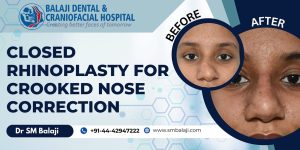Patient with facial asymmetry
The patient is a 30-year-old male from Jamshedpur in Jharkhand, India. Growth of his facial bones was normal until he became a teenager. It was around that time that the right side of his lower face began to develop an asymmetry. This slowly but gradually worsened to the point where he now has gross asymmetry of his face.
Eating most foods had also become very difficult because of an increasing left posterior open bite. He also soon developed pain in his right temporomandibular joint. These two issues have been present for over 10 years now. He had also faced significant bullying during his school and college days. This has made him an introvert.
Initial surgery for correction of asymmetry in a nearby state
Desiring to get this treated, he had approached a maxillofacial surgeon in a neighboring state for consultation. A detailed examination had been performed and he had been advised surgery. He had subsequently undergone reduction of the mandibular angle and shortening of the ramus on the right side. A piece of the ramus had been removed and the ends brought together with titanium plates and screws.
The patient however was greatly disappointed by the results of the surgery. He was left with an unsightly scar on the right side of his face due to the extraoral approach adopted by the surgeon. The patient also realized that his chewing problem and pain remained the same. There was also an increase in the muscle mass on the right side of the face. There was also an increase in his facial asymmetry.
He had approached another oral and maxillofacial surgeon who had advised bone grafting from the iliac crest(hip bone graft). The patient’s mandibular deficiency caused by the first surgery was addressed through the use of this graft, but this led to compromised facial esthetics for the patient.
Referral to our hospital for treatment of his facial deformity
Feeling despondent by the turn of events, he had approached a local surgeon in his hometown. Upon examining the patient and realizing the magnitude of damage caused by the first two surgeries, the surgeon had immediately referred the patient to our hospital. Our hospital is renowned for facial asymmetry correction in India. Facial asymmetry surgery is routinely performed utilizing distraction osteogenesis surgery.
Initial presentation for treatment at our hospital
Dr SM Balaji, facial asymmetry surgeon, examined the patient and obtained a detailed oral history. He also ordered for comprehensive imaging studies including a 3D CT scan. It was clear that this was a case of idiopathic hyperplastic right mandibular ramus.
Clinical examination revealed an open bite on the left side and increased muscle mass on the right side of the face; however, OPG revealed that the right mandible was short by 10 mm. The 3D CT scan also revealed defective mandibular ramus length on the right side as well. Iatrogenic damage from the previous surgeries was also clearly visualized in the imaging studies.
Treatment planning explained in detail to the patient
Dr SM Balaji explained that correction of his asymmetry required right mandibular ramus distraction osteogenesis. A distraction of about 10 mm was planned for the patient. Subsequent rib grafting was planned for correction of the iatrogenically induced mandibular angle defect.
Distraction devices can be classified into external devices and internal devices. Oral and Maxillofacial Surgery predominantly uses internal devices. Orthopedic surgery however mainly relies on external devices. Completion of the distraction process is always followed by the consolidation phase. This is for the bone at the surgical site to be strengthened.
Successful placement of the Univector mandibular distractor
Under general anesthesia, an incision was first placed in the right mandibular posterior region. This was followed by elevation of a flap. Horizontal bone cuts were then made and the Univector mandibular ramus distractor was fixed using titanium screws. Distractor function was checked and was found to be optimal.
Following the placement of the distractor, a sulcular incision was placed in the maxilla. Le Fort 1 bone cuts were made and the maxilla was mobilized. The posterior end of the left maxilla was fixed using transosseous wires. This would enable correction of the occlusal cant. Hemostasis was achieved and closure was done using resorbable sutures.
Postsurgical distraction performed for asymmetry correction
Interarch wiring was done. A latency period of about 6-7 days was allowed for settling down of the surgical site. Following the latency period, the distractor was activated by 1 mm each day. After achieving a satisfactory increase in length of 10 mm, the distraction was stopped. Two weeks following completion of distraction, a straight plate was fixed to the left posterior maxilla to prevent further downward movement.
Total patient satisfaction with the results of the surgery
The patient was extremely satisfied with the results of the surgery. His facial asymmetry had been corrected and his entire face was in harmony. The patient’s parents were also very happy with the results and said that the patient had become noticeably happier following surgery.
They were instructed to return after a few months for removal of the distractor after bony consolidation had been demonstrated at the surgical site. The patient and his parents expressed understanding of the same.





